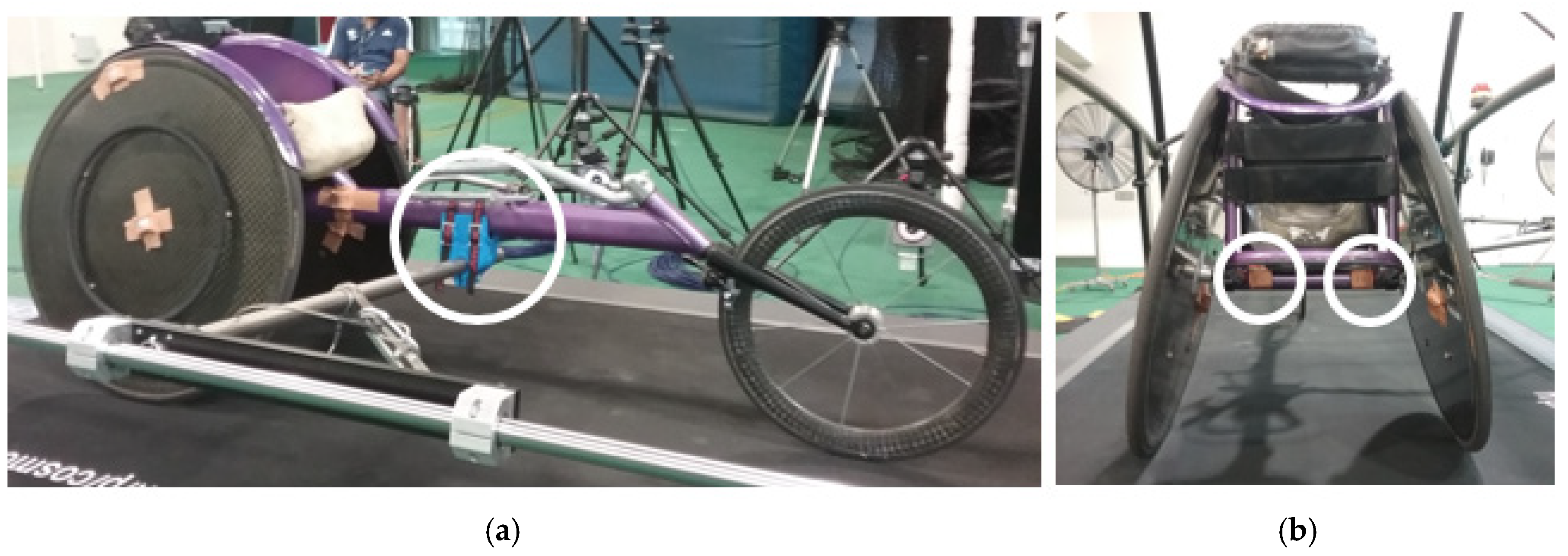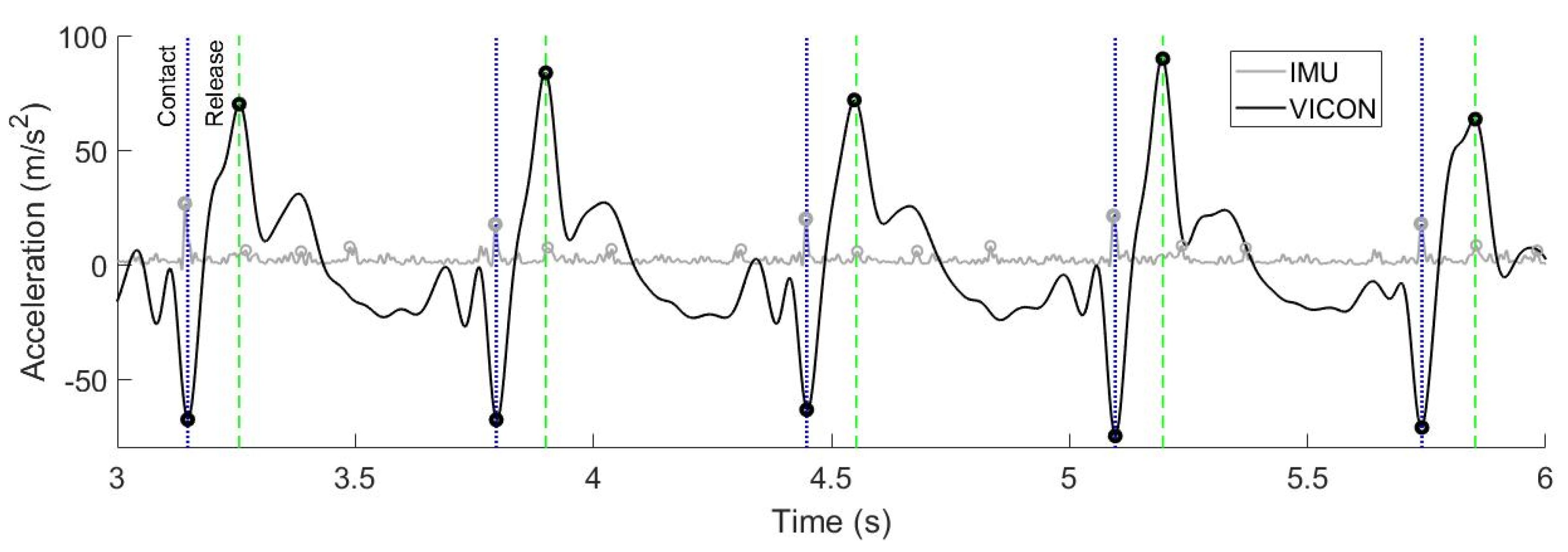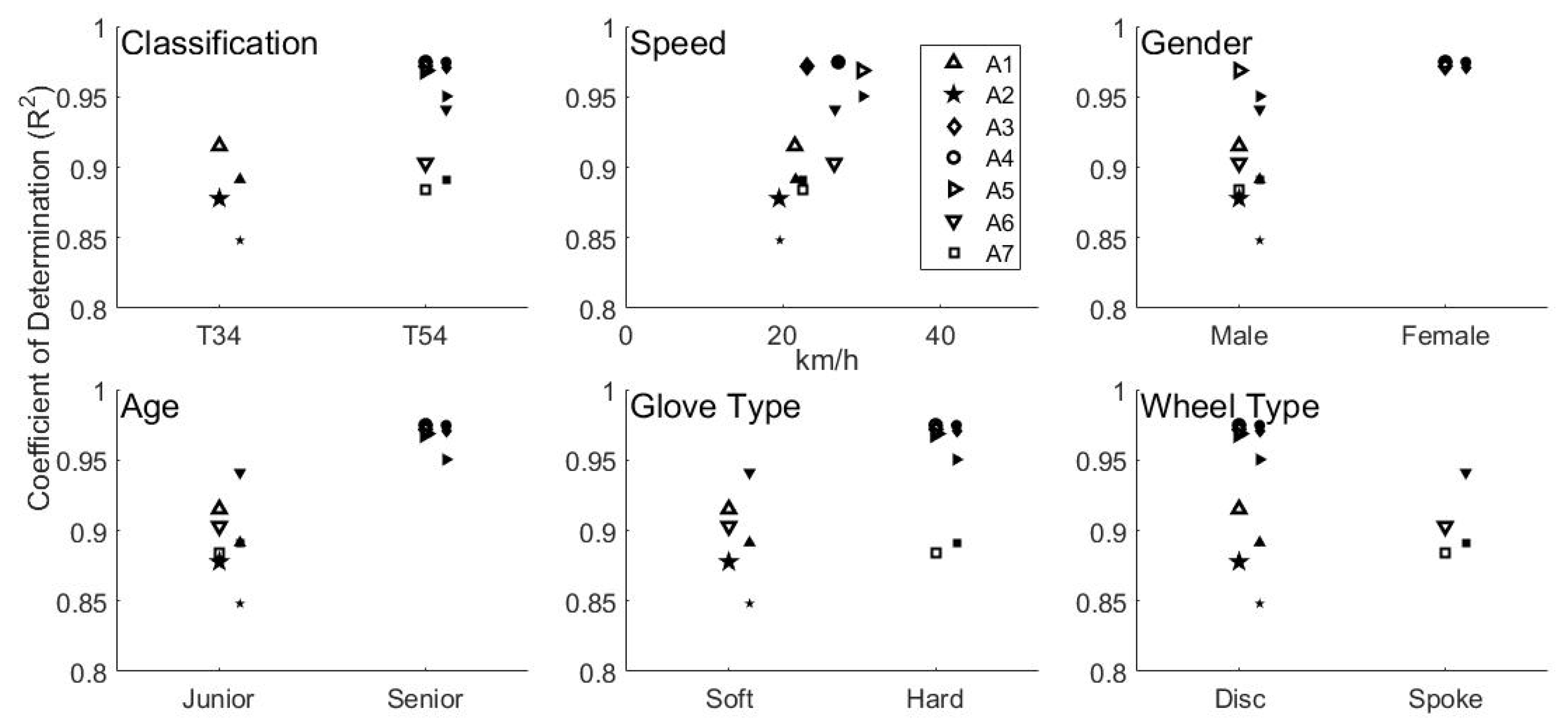1. Introduction
With the winning margins of wheelchair racing events being within hundredths of a second, the use of an optimal propulsion technique, and its quantitative assessment on-track is critical to an athlete’s success. Stroke speed, stroke length (time between successive contacts), push times (time when the hand is in contact with pushrim) and recovery times represent key characteristics important for the kinematic analysis of wheelchair propulsion. These parameters are a crucial requirement in diagnosing the efficiency of the interaction of force transfer between the hand and wheel. Additionally, it is crucial to understand the relative timings between the hands (kinematic asymmetries), which are common across the athletic and non-athletic wheelchair populations, and are often a result of the type of physical impairment [
1]. Asymmetries can negatively impact propulsion, such as through steering difficulty [
2,
3] and so kinematic measurement of asymmetry requires the accurate identification of key propulsion parameters including contact times [
4].
Inertial measurement units (IMUs) have demonstrated success in the evaluation of wheelchair kinematics [
5]. Previous research has been constrained to the determination of wheelchair contact and hence stroke time, however has not been extended into intra-stroke profiling. Use of IMUs can provide in-field assessment to measure the variability in propulsion during a race, which is otherwise unavailable using the current gold standard of motion capture (kinematics) or use of instrumented wheels (kinetics). Although instrumented wheels such as the SMARTwheel are commercially available, they are infrequently implemented by wheelchair racing athletes, as the wheel mass is of comparable magnitude to the wheelchair itself [
6,
7], with increases in system mass demonstrated as being detrimental to performance [
8]. Additionally, use of IMUs can provide an objective method of identifying contact, which is less subject to parallax and perspective errors of video analysis. Following the development of code to automate acceleration data to accurately and reliably identify contact, data processing becomes a semi-automated process, with substantially reduced computational requirements as compared with the manual digitisation of video, the current gold standard measurement method [
5].
The ability of the IMU to identify propulsion characteristics is reliant on the underlying noise of the signal, as well as athlete equipment (such as glove and wheel types), and technique, which influences the magnitude of peak impacts. Wheelchair racing athletes typically wear gloves as a form of protection from the ballistic striking motion encountered in wheelchair racing. These gloves are typically made from leather or a thermoplastic. The variation in the stiffness of these gloves, or the use of disc and spoked wheels can influence the characteristic acceleration signal demonstrating contact between the athlete and wheelchair.
The aim of this research was to determine the capability of IMUs in automatically identifying both contact and release times (and hence push time) across a number of different athlete and wheelchair configurations as a measure of robustness of the solution.
2. Materials and Methods
2.1. Athlete Selection
Seven wheelchair racing athletes from the national level junior (
n = 4, <19 years of age, 4.0 ± 0.58 years of experience) and senior (
n = 3, >19 years of age, 8.33 ± 3.28 years of experience) program were recruited for this study (
Table 1). The population sample facilitated assessment of the robustness of the method across varying athlete anthropometries (mass and gender), push technique (propulsion speed), athlete ability (classification and age (junior or senior)), and equipment (wheel type and glove type). Research was constrained to classifications demonstrating fair to good functional strength in the arms and trunk (T53, T54: Spinal Cord Injury; T34: Cerebral Palsy) [
9]. Further classifications and wheelchair sports were excluded to prevent demographics confounding observations (i.e., seating posture, physical impairment in upper extremity). Athletes provided written, informed consent, with ethical approval obtained by the University of Adelaide and the Australian Institute of Sport.
2.2. Experimental Propulsion Task
Athletes completed trials at constant velocity on a treadmill (H/P/Cosmos
® Saturn, Traunstein, Germany) inclined to 1% [
10]. Belt velocity was comparable to individual regular race training velocity (92.12% ± 2.36% of mean race velocity at an international competition held within six months of data collection [
11,
12]). Athletes who were new to treadmill propulsion completed a familiarisation protocol, whereby treadmill velocity was incrementally increased until testing velocity was reached. A five-minute active recovery period was provided between trials to minimise effects of fatigue.
The front fork of the wheelchair was fastened to the treadmill using a custom designed clamp, which prevented lateral translations of the wheelchair, but allowed normal fore-aft movement of the wheelchair within a safe operating range (
Figure 1a). Any potential detriments to athlete performance from treadmill based propulsion did not impede the capabilities of the IMU in measuring the temporal characteristics of propulsion.
2.3. Measurement System
Triaxial acceleration data were collected using two synchronised IMUs (
Figure 1b; IMeasureU, Auckland, New Zealand; Accelerometer: ±16 g; Gyroscope: ±2000°/s; Compass: ±1200 μT) sampling at 500 Hz. Units were located on the left and right axle housings of the wheelchair frame (FL, FR). Each unit was carefully fasted using double sided adhesive tape and secured using fabric tape to prevent all unwanted lateral translations and vibrations of the units. Pilot testing revealed the accelerations measured by the IMU were low (contact peak <4 g) with respect to the sensing range, suggesting the IMUs used were appropriate for this research.
Three high speed Sony PXW-FS7 video cameras (located at the rear and perpendicularly left and right of the athlete-treadmill system) were utilised to validate the push durations calculated by the IMUs. Cameras operated at a sampling frequency of 100 Hz and shutter speed of 1/1000 s. Three distinct contacts were made between the hands and wheels followed by a stationary period of 20 s to synchronise IMU and video data.
2.4. Data Processing
Resultant accelerometer data were all low pass filtered with a bidirectional low-pass filter using a −6 dB cut off frequency of 100 Hz, which was determined through performing independent residual analyses for each IMU, athlete and speed. 100 Hz represented the highest recommended cut off frequency, and was nominated due to the low likelihood of altering temporal characteristics. The resultant acceleration vector was used. This accounted for orientation discrepancies during placement and ensured data for both FL and FR are in the same global coordinate system.
Contact and release points were automatically detected using a custom peak-detection algorithm which located local maxima, with push time calculated as the time between successive contacts. The algorithm specified minimum distance between like points (contact or release) was 0.45 s based on previous literature [
13], with athlete-specific minimum peak thresholds manually defined based on visual inspection (0.3–17 m/s
2). Temporal parameters were validated against video, which served as the gold standard measurement [
5]. Video data was manually digitised (Kinovea v0.8.15
www.kinovea.org) with hand contact and release identified as the first and last frame where any part of the athlete’s hand or glove was in contact with the pushrim, respectively.
2.5. Statistical Analysis
Reliability and repeatability measures were obtained through Intraclass Correlation Coefficients (ICC). Two independent raters (both familiar with wheelchair acceleration data and video) performed manual digitisation on the same video, and analysed IMU data using the custom peak detection algorithm. Both raters performed a repeated assessment of tasks following a period of two weeks with no exposure to the data. Appropriate reliability and repeatability required ICC > 0.9 [
14].
A mathematical relationship established the agreement between the video-based and IMU-based contact timing data. It was defined for this research that an adjusted coefficient of determination (R2) value > 0.97 (±1 video frame (0.01 s)) demonstrated excellent goodness of fit, R2 > 0.91 (±2 video frames (0.02 s)) was very good, R2 > 0.80 (±3 video frames (0.03 s)) was good, with R2 < 0.80 considered average. Results of the above regression were then ranked and compared across athlete demographics using a Mann Whitney U test. Pearson Correlations were used to establish the relationship present between speed and reliability. All statistical calculations were performed using IBM SPSS Statistics 21 Software for Windows (SPSS Inc., Chicago, IL, USA).
A total of 221 push times were analysed (4 junior athletes × 13 push times × 2 speeds + 3 senior athletes × 13 push times × 3 speeds) for each hand (442 total).
3. Results
Excellent inter- and intra-rater reliability (ICC > 0.95) were obtained for the manual digitisation of high speed video. For all reliability assessments, mean absolute error in the time for push length was <0.013 s, with standard deviation being <0.058 s and <0.013 s for IMU, and video defined contacts, respectively.
IMUs were effectively capable of automatically identifying contact, however the algorithm located release less reliably, without also detecting noise (
Figure 2). At this stage automatic detection of release points is not plausible without the assistance of VICON data. As the release point was not always reliably detected, the remainder of this results section will focus solely on the reliability of identifying contact.
Athlete-specific characteristics were observed to influence the robustness of the IMU method, and hence the level of agreement with the video obtained contact timings. Results from the Mann U Whitney test revealed that, glove type (U = 6; W = 34;
p = 0.02), and wheel type (U = 12; W = 22;
p = 0.26) were not observed to impede the effectiveness of IMUs in determining contact (
Figure 3). Statistical affects were identified between the reliability of IMU and video derived push lengths, with speed (
r = 0.72;
p < 0.01), gender U = 0; W = 55;
p = 0.05), athlete classification (U = 4; W = 14;
p = 0.02) and age (U = 0; W = 36;
p < 0.01), or a compounding affect between these. Effect sizes ranged between small (Wheel
r = 0.05; Gender
r = 0.05), medium (Glove
r = 0.11; Age
r = 0.15; Classification
r = 0.11) and large (Speed
r = 0.72) [
15].
4. Discussion
The aim of this research was to investigate the ability of IMUs to perform intra-stroke profiling of wheelchair propulsion, and the influence of athlete and wheelchair demographics on this ability. It was observed that IMUs provided a reliable and repeatable method of identifying contact, but not the release point. Release was able to be detected, however as acceleration signals at this moment were comparable to the magnitude of signal noise, it may not allow completely autonomous processing. The accuracy of the IMU method was influenced both through placement location and athlete technique. Due to the high reliability of the IMU methodology, it is plausible to perform automated, in-field analysis of propulsion, and analyse the presence of asymmetry during motion.
Contact is a far more ballistic motion than release of the hand on the pushrim, which can explain the reduced accuracy of its detection. A single athlete demonstrated consistent identification of release points. Qualitative assessment of performance suggests this may be likened to a flicking motion of the wrist upon release. Without kinetic validation, it can be hypothesized that this motion does not maximize athlete efficiency. Whilst IMUs may have a limited capacity to quantify the release time, they can still assist in kinematic profiling, by recognizing whether inefficient release techniques are being used.
Results suggest that differences in reliability of the IMU are not associated so much with athlete equipment (wheel type or glove type) but are related to individual propulsion techniques. It is suggested that IMUs demonstrate greater agreement with the current gold standard method when used with more experienced, senior athletes, and at higher propulsion speeds. Females demonstrate different propulsion kinematics [
16], which may provide the rationale as to why reliability and gender are correlated, however due to the small population sample size (
n = 2), and the potential of systematic error, this cannot be confirmed from the results of this study. Athlete classification, which influences kinematic technique was not demonstrated to influence the reliability of the IMUs in determining contact. However, both the classifications researched had full function of their upper extremities. It is expected that level of activity limitation (and therefore classification) would be an influencing factor when concerning athletes with different types of impairment, specifically when reduced muscular function and greater physical asymmetry is present in the upper extremities.
5. Conclusions
Identification of key propulsion events from IMU data were found to be reliable for contact and push length, but not for release. The reliability of IMU obtained data was impacted by athlete propulsion technique. The robustness of detecting contact was not influenced by classification, wheel type, or glove type, however improved reliability may be associated with athlete speed, gender and variability in technique.








